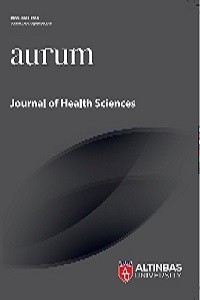Determination of Radiation Exposure of Students During Their Internships Using OSL Dosimeter
To keep the radiation exposure under control is the golden rule for radiation protection. Radiation dose monitoring is performed for radiation workers however no dose follow-up has for students. So in this study it was aimed to determine the level of radiation exposure of students who trained in medical imaging techniques program. Methods: This work is assessed the radiation exposure of 132 students during their internships in the department of radiology, nuclear medicine and oncology with the aid of optically stimulated luminescence (OSL) dosimeters between the years of 2017-2019. Results: For the students in the roles of trainers, maximum accumulated equivalent doses were found to be 2.07 and 2.14 mSv for body Hp(10) and skin Hp(0.07), respectively. The minimum accumulated equivalent dose was 0.00 mSv for 112 students both body and skin. The mean Hp(10) and Hp(0,07) for the 1st, 2nd, 3rd and 4th periods were calculated as 0.38±0.23mSv and 0.35±0.20mSv, 0.42±0.27mSv and 0.34±0.23mSv, 0.37±0.18mSv and 0.30±0.12mSv, 0.63±0.22mSv and 0.34±0.04mSv, respectively. Conclusions: It was determined that all absorbed doses found under the radiation safety regulations. However, it was seen that some students whose absorbed dose were found a little bit high acted more courageous with the self-confidence.
Anahtar Kelimeler:
Radiation exposure, OSL, absorbed dose, whole body exposure, skin exposure, student
Determination of Radiation Exposure of Students During Their Internships Using OSL Dosimeter
To keep the radiation exposure under control is the golden rule for radiation protection. Radiation dose monitoring is performed for radiation workers however no dose follow-up has for students. So in this study it was aimed to determine the level of radiation exposure of students who trained in medical imaging techniques program. Methods: This work is assessed the radiation exposure of 132 students during their internships in the department of radiology, nuclear medicine and oncology with the aid of optically stimulated luminescence (OSL) dosimeters between the years of 2017-2019. Results: For the students in the roles of trainers, maximum accumulated equivalent doses were found to be 2.07 and 2.14 mSv for body Hp(10) and skin Hp(0.07), respectively. The minimum accumulated equivalent dose was 0.00 mSv for 112 students both body and skin. The mean Hp(10) and Hp(0,07) for the 1st, 2nd, 3rd and 4th periods were calculated as 0.38±0.23mSv and 0.35±0.20mSv, 0.42±0.27mSv and 0.34±0.23mSv, 0.37±0.18mSv and 0.30±0.12mSv, 0.63±0.22mSv and 0.34±0.04mSv, respectively. Conclusions: It was determined that all absorbed doses found under the radiation safety regulations. However, it was seen that some students whose absorbed dose were found a little bit high acted more courageous with the self-confidence.
Keywords:
Radiation exposure, OSL, absorbed dose, whole body exposure, skin exposure, student,
___
- Baumann, M. K. (2008). Exploring the role of cancer stem cells in radioresistance. Nat. Rev. Cancer, 545-554.
- Bernier, J. H. (2004). Radiation oncology: a century of achievements. Nat. Rev. Cancer, 737-747.
- Fellinger J., H. J. (1984). Calculation and experimental determination of the fast neutron sensitivity of OSL detectors with hydrogen containing radiators. Nuclear Instruments and Methods in Physics Research Section A: Accelerators, Spectrometers, Detectors and Associated Equipment, 154-156.
- Gilvin P.J., A. J. (2015). Quality Assurance in Individual Monitoring for External Radiation. Neuherberg: EURADOS.
- IAEA. (1999). Occupational Radiation Protection, No: RS-G-1.1. Vienna: IAEA.
- ICRP. (2007). The 2007 Recommendations of the International Commission on Radiological Protection. ICRP publication 103. Oxford, UK.: Pergamon Press. International Electrotechnical Commission. (2007). International Standard IEC 62378-1. Geneva: IEC.
- Jahn A., S. M. (2010). 2D-OSL-dosimetry with beryllium oxide. Radiation measurements, 674-676.
- Loya M, S. L.-C. (2016). Measurements of radiation exposure of dentistry students during their radiological training using thermoluminescent dosimetry. Applied Radiation and Isotopes, 234-238.
- Lundberg TM, G. P. (2002). Measuring and minimizing the radiation dose to nuclear medicine technologists. J Nucl Med Technol, 25-30.
- McKeever, S. (2001). Optically stimulated luminescence dosimetry. Nuclear Instruments and Methods in Physics Research Section B: Beam Interactions with Materials and Atoms, 29-54.
- Reed, A. (2011). The history of radiation use in medicine. Journal of Vascular Surgery, 3-5.
- Sommer M, H. J. (2006). Investigation of a BeO-based optically stimulated luminescence dosimeter. Radiat. Prot. Dosimetry, 394-397.
- Statkiewicz Sherer M.A., V. P. (2018). Radiation Protection in Medical Radiography. Missouri: Elsevier.
- Verellen, D. D. (2007). Innovations in image-guided radiotherapy. Nat. Rev. Cancer, 949-960.
- Weichselbaum, R. H. (2011). Oligometastases revisited. Nat. Rev. Clin. Oncol., 378-382.
- ISSN: 2651-2815
- Yayın Aralığı: Yılda 3 Sayı
- Başlangıç: 2018
- Yayıncı: Altınbaş Üniversitesi
Sayıdaki Diğer Makaleler
Determination of Radiation Exposure of Students During Their Internships Using OSL Dosimeter
Handan TANYILDIZI KÖKKÜLÜNK, İrfan AYDIN, Özlem YILDIRIM
Özgül ÖZKOÇ, Zuhal ÇAYIRTEPE, İnci OKTAY
Diagnosis and Treatment Methods of Autoimmune Myasthenia Gravis: A Systematic Review
Melike Nur YANGIN, Yaşar ZORLU, Feride SEVERCAN
